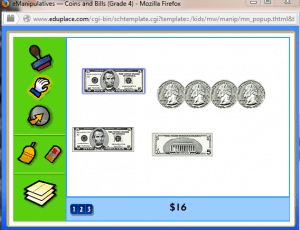Math e-Manipulatives and Math Graphic Organizers
 Math e-Manipulatives - As you prepare for a lesson with manipulatives, you can conveniently plan activities with the eManipulatives. Then in class, students can use real manipulatives, or you can demonstrate on the computer. eManipulatives include: Base Ten Blocks, Number Line, Fractions, Fractions and Decimals, Hundred Chart, Two-Color Counters, Counters, Coins and Bills, Connecting Cubes, Addition Table, and Multiplication Table.
Math e-Manipulatives - As you prepare for a lesson with manipulatives, you can conveniently plan activities with the eManipulatives. Then in class, students can use real manipulatives, or you can demonstrate on the computer. eManipulatives include: Base Ten Blocks, Number Line, Fractions, Fractions and Decimals, Hundred Chart, Two-Color Counters, Counters, Coins and Bills, Connecting Cubes, Addition Table, and Multiplication Table.
Use the Graphic Organizers to help students visually organize mathematical concepts and vocabulary: Different Ways to Write a Number, Mental Math and Estimation Strategies, Multiplication Properties, Exploring Prime Numbers, Different Ways to Organize Data, Different Types of Polygons, Comparison of Fractions and Decimals, and How to Plot an Ordered Pair.
Know number names and the count sequence.
CCSS.Math.Content.K.CC.A.1
Count to 100 by ones and by tens.
CCSS.Math.Content.K.CC.A.2
Count forward beginning from a given number within the known sequence (instead of having to begin at 1).
Understand place value.
CCSS.Math.Content.1.NBT.B.2
Understand that the two digits of a two-digit number represent amounts of tens and ones. Understand the following as special cases:
CCSS.Math.Content.1.NBT.B.2.a
10 can be thought of as a bundle of ten ones — called a "ten."
Add and subtract within 20.
CCSS.Math.Content.2.OA.B.2
Fluently add and subtract within 20 using mental strategies.2 By end of Grade 2, know from memory all sums of two one-digit numbers.
Understand place value.
CCSS.Math.Content.2.NBT.A.1
Understand that the three digits of a three-digit number represent amounts of hundreds, tens, and ones; e.g., 706 equals 7 hundreds, 0 tens, and 6 ones. Understand the following as special cases:
CCSS.Math.Content.2.NBT.A.1.a
100 can be thought of as a bundle of ten tens — called a "hundred."
Use place value understanding and properties of operations to perform multi-digit arithmetic.
CCSS.Math.Content.3.NBT.A.3
Multiply one-digit whole numbers by multiples of 10 in the range 10-90 (e.g., 9 × 80, 5 × 60) using strategies based on place value and properties of operations.
Develop understanding of fractions as numbers.
CCSS.Math.Content.3.NF.A.1
Understand a fraction 1/b as the quantity formed by 1 part when a whole is partitioned into b equal parts; understand a fraction a/b as the quantity formed by a parts of size 1/b.
CCSS.Math.Content.3.NF.A.2
Understand a fraction as a number on the number line; represent fractions on a number line diagram.
CCSS.Math.Content.3.NF.A.2.a
Represent a fraction 1/b on a number line diagram by defining the interval from 0 to 1 as the whole and partitioning it into b equal parts. Recognize that each part has size 1/b and that the endpoint of the part based at 0 locates the number 1/b on the number line.
CCSS.Math.Content.3.NF.A.3
Explain equivalence of fractions in special cases, and compare fractions by reasoning about their size.
CCSS.Math.Content.3.NF.A.3.a
Understand two fractions as equivalent (equal) if they are the same size, or the same point on a number line.
CCSS.Math.Content.3.NF.A.3.b
Recognize and generate simple equivalent fractions, e.g., 1/2 = 2/4, 4/6 = 2/3. Explain why the fractions are equivalent, e.g., by using a visual fraction model.
Compare two fractions with the same numerator or the same denominator by reasoning about their size. Recognize that comparisons are valid only when the two fractions refer to the same whole. Record the results of comparisons with the symbols >, =, or <, and justify the conclusions, e.g., by using a visual fraction model.
Gain familiarity with factors and multiples.
CCSS.Math.Content.4.OA.B.4
Find all factor pairs for a whole number in the range 1-100. Recognize that a whole number is a multiple of each of its factors. Determine whether a given whole number in the range 1-100 is a multiple of a given one-digit number. Determine whether a given whole number in the range 1-100 is prime or composite.
Extend understanding of fraction equivalence and ordering.
CCSS.Math.Content.4.NF.A.1
Explain why a fraction a/b is equivalent to a fraction (n × a)/(n × b) by using visual fraction models, with attention to how the number and size of the parts differ even though the two fractions themselves are the same size. Use this principle to recognize and generate equivalent fractions.